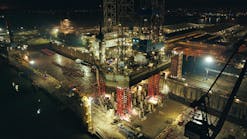Robots under review for role in hazardous, remote locations
Charlotte Skourup
John Pretlove
ABB Strategic R&D for Oil, Gas and Petrochemicals, Norway
Throughout most industries, the aim is to raise productivity and efficiency through increased automation. One important enabler has been the use of industrial robots designed to perform repetitive, heavy, dirty, and dangerous tasks.
In the oil and gas sector, robots have only been used in niche applications where the main driver has been safety, but this trend is changing. Companies have started to explore new roles for robots, one being the remote operation of oil and gas fields, particularly in hazardous environments, conflict zones, and environmentally harsh areas.
The ABB robot test laboratory in Oslo, Norway.
Picture this scenario: an orange robot moves around a site, performs various routine inspections and replaces a safety valve. This robot works alongside two others, all supervised by a human operator based hundreds of miles away in the process control center.
The human supervisor has defined and initiated the maintenance tasks in response to a condition-based monitoring (CBM) report generated by the automation system. With overall responsibility for safety, the operator instructs the automation system to re-schedule the sub-tasks. Via a 3-D camera mounted on one of the robots, the operator inspects the machinery remotely and identifies further components requiring removal and replacement.
Although this scene is set sometime in the future, it is not far from reality. It is an example of how robotic technology could be taken a step further and moved into oil and gas facilities to improve HSE and increase productivity.
The offshore sector faces numerous issues that call for novel technical solutions. Recovering oil and gas from new or existing reservoirs has become more demanding with reduced profit margins. Many of the more accessible fields have already been exploited, leaving the more remote and technically challenging reserves for future exploration. This combined with the expectations of continuous market growth, demand for overhead savings and improved energy efficiency, alongside a decline in experienced workers, all offer possibilities for investment in alternative automated solutions.
Offshore installations impose different challenges on the design and functionality of robotics systems. The robot must be approved as explosion-proof, and capable of operating in harsh weather conditions. Such specifications are not usually required for reliable robot operations in conventional manufacturing process plants onshore. System integration is another technical challenge.
Robots cannot replicate the human senses and therefore cannot provide an exact representation of operations as performed today. However, robots can draw on sensors that human operators cannot, such as x-ray and computer chromatography. This allows them to inspect processes in greater detail while drawing on remote human operator skills.
As robotic technology continues to develop, there is also a clear HSE incentive for oil and gas companies to automate offshore tasks such as pipe handling, which represent high-risk operations for human employees.
Test facilities
Since early 2006, ABB has been working with StatoilHydro to investigate, demonstrate, and test concepts for future robotized oil and gas applications. At the laboratory in Oslo, three ABB robots communicate daily to perform inspection tasks, directed either by a control system or a remotely located human operator. The latter may employ a 3D model to interact with the robots, defining and initiating tasks and receiving feedback. The robots act as the operator’s extended eyes, ears and hands, maintaining and monitoring the status of the process infrastructure. In these tests, typically one robot is used for inspection and the other two for cooperative maintenance. In addition, a waterproof ABB robot is located outdoors at the StatoilHydro site in Kårstø on the west coast of Norway.
During a recently completed six-month test, the robot operated outdoors in temperatures ranging from -15° C (+5° F) to +20° C (+68° F), in extreme winds, ice, snow, and rain. The robot had only one unplanned stop, most likely due to cold weather (-12° C, or +10° F), but it resumed work after a proper warming-up sequence. The robot has since been shipped back to ABB for further analysis on how the weather influenced its performance.
One of the successfully completed tasks was a non-destructive test in storms and heavy rain. No human operator would have been permitted to enter the offshore process area to perform an equivalent test under similar bad weather conditions.
The use of robots within the oil and gas industry has to date been limited. The industry has generally only automated processes that are either difficult or impossible for people to perform. Oil and gas facilities have huge potential for improved productivity with the use of robotic automation. In addition to productivity and efficiency gains, robots used for high-risk applications will dramatically improve HSE levels.
However, the degree to which the oil and gas industry benefits from robotic technology is dependent on how willing the industry is to change in order to fully integrate the technology and overcome the technical and organizational challenges.






